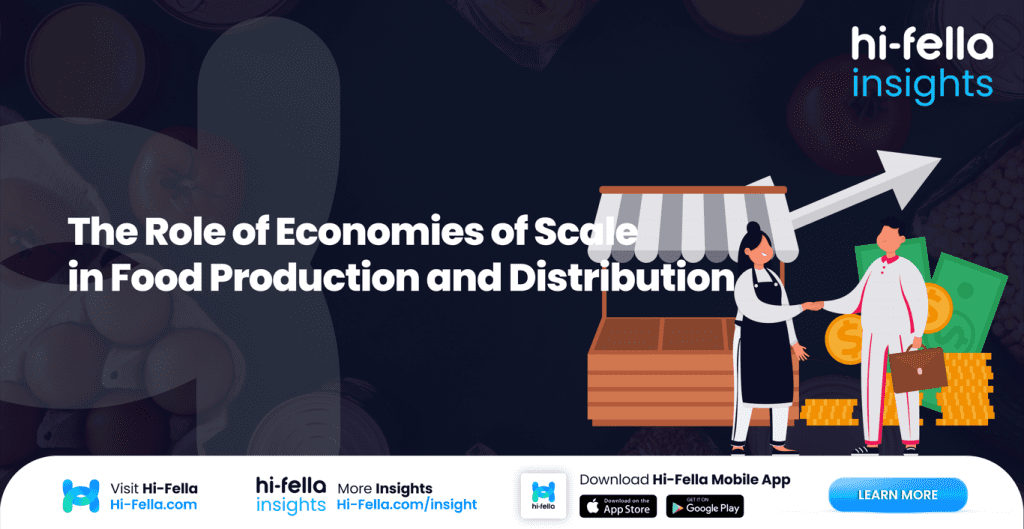In food production and distribution, size matters—but not just for show. The larger your scale, the more opportunities you have to optimise operations, reduce costs, and build a competitive edge. This is the core idea behind economies of scale—a principle that has shaped how food moves from farms and factories to tables around the world.
Whether you’re a small local brand looking to expand or a regional supplier thinking of exporting, understanding economies of scale isn’t just useful—it’s strategic. Let’s explore how scale affects everything from ingredient sourcing to logistics, and what that means for your bottom line.
What Are Economies of Scale?
Economies of scale describe a powerful financial principle: as a business grows and produces more, it can reduce its average cost per unit. In other words, the more you produce or distribute, the cheaper it becomes to make each product—but only if your operations are structured to take advantage of that scale.
This cost reduction happens through two major channels: internal and external economies of scale.
Internal economies of scale are efficiencies that arise from within your own operations. These include things like:
- Bulk purchasing: Buying raw materials in large volumes typically results in supplier discounts. For instance, a food manufacturer buying 100 tonnes of rice per month will pay less per kilogram than a small bakery purchasing 100 kilograms a week.
- Process automation: Larger production volumes justify investing in automated machinery, which lowers labour costs and boosts output per hour. For example, a ready-meal factory might use a robotic tray filler to pack thousands of meals per hour—at a much lower labour cost per unit than a manual line.
- Specialised labour and equipment: As scale increases, a business can afford to hire experts or use dedicated machinery for each task. That specialisation increases speed and consistency, further reducing waste and inefficiencies.
- Spreading fixed costs: Overheads like rent, management salaries, and certifications cost the same whether you produce 10,000 or 100,000 units. The more you produce, the less each unit “pays” toward those fixed costs.
Then there are external economies of scale, which come from outside the business but still benefit it as it grows. These might include:
- Improved infrastructure: When you operate in a mature food hub—say, a logistics zone near a major port—you benefit from lower transport and warehousing costs because the infrastructure is already optimised for scale.
- Industry-specific knowledge and support: As industries mature, support systems emerge—such as better supplier networks, export financing, and access to skilled workers—which collectively reduce individual business costs.
- Cluster benefits: When many food companies operate in one region, they can share services like cold storage, waste management, or R&D centres. This reduces duplication of resources and gives even mid-sized players access to cost-saving facilities.
However, size alone doesn’t create efficiency. If growth isn’t well-managed—if your systems can’t handle scale, or your logistics become chaotic—costs can rise just as fast as volume. That’s why economies of scale only materialise when your operations, supply chain, technology, and strategy are built for expansion.
In food production and distribution, understanding economies of scale is key to pricing competitively, improving margins, and meeting demand consistently—especially when entering export markets where price and reliability are non-negotiable.
When you’re ready to grow smartly, not just grow big, hi-fella can connect you with the global opportunities, networks, and platforms that help you scale efficiently and profitably.
Lowering Production Costs at Volume
Food production, especially in processed categories, thrives on volume. When you order raw ingredients in bulk—whether it’s wheat flour, cooking oil, or packaging materials—you unlock lower prices from suppliers. This alone can shrink your unit costs significantly.
You also spread fixed costs (equipment, rent, certifications) across more units. For example, the cost of operating a packaging line is the same whether you run 10,000 units or 100,000. The more output you generate, the less each unit “pays” for those overheads.
Brands that scale production efficiently can afford to price competitively, offer promotions, or improve their margins—something smaller producers often struggle to match without partnerships or co-manufacturing support.
Distribution: Where Scale Really Flexes Its Muscles
If there’s one area where economies of scale shine, it’s distribution. Shipping 50 cartons of snack bars per week is very different from moving 5,000 cartons per day. Larger volumes mean better deals with freight carriers, warehouse networks, cold chain providers, and retailers.
Bigger producers can also justify investing in technology and automation—like smart inventory systems or AI-powered route optimisation—that make logistics faster and cheaper. Over time, these systems help reduce delivery errors, shrink lead times, and manage inventory with tighter precision.
This matters especially for export businesses. Distributors and importers favour suppliers who can deliver at scale, consistently, and within tight cost targets. Being able to scale production and distribution can often be the deciding factor in landing big contracts or gaining shelf space in international retail.
Brand Strength and Market Influence
Economies of scale don’t just impact costs—they shape brand power. When a food business reaches a certain scale, it gains market influence: stronger negotiating power with suppliers, more visibility with retailers, and better promotional rates from media platforms.
Larger-scale businesses can also afford to diversify product lines, test new SKUs, or localise flavours without overextending resources. That gives them agility in responding to market trends while maintaining pricing power—a critical edge in fast-moving consumer segments.
And perhaps most importantly, scale offers resilience. When prices fluctuate or supply chains face disruption, big players have more room to absorb shocks. That’s not luck—it’s strategic positioning built over time through scale.
Can Smaller Producers Compete?
Yes—but with a caveat. Smaller food producers don’t have the same cost advantages, but they can compete by specialising, building premium brands, and leveraging smart partnerships. Niche positioning, artisanal quality, local sourcing stories, or functional food claims can command higher margins, even at smaller volumes.
What matters is understanding your growth path. Even smaller producers can unlock economies of scale by joining cooperatives, using shared production facilities, or consolidating orders through export platforms.
The key is to plan for scale—even if you’re not there yet. Know your break-even point. Forecast what happens when your volume doubles. Think about automation early, not just when you’re overwhelmed.
Scaling Smartly Through Trade Platforms
Reaching economies of scale isn’t just about buying a bigger machine—it’s about reaching more buyers, faster. That’s where platforms like hi-fella come in.
hi-fella helps food producers and suppliers connect with global distributors, showcase their products at international exhibitions, and access export-import insights that make scaling smoother. Whether you’re an SME building your first export play or a mid-size manufacturer ready to go regional, hi-fella gives you the network, visibility, and tools to grow with confidence.
From packaging support to logistics matchmaking, hi-fella is designed to help you scale smart—not just scale big.
Scale Is Power—But Smart Scale Is Profitable
In food production and distribution, the ability to scale isn’t just about size—it’s about leverage. It’s what turns efficiency into profit, visibility into brand equity, and systems into long-term sustainability.
Whether you’re producing energy bars, canned sauces, frozen meals, or beverage concentrates, the path to real growth runs through scale-ready systems and market-ready strategy.
And when you’re ready to explore those markets, connect with partners, and scale with confidence, let hi-fella be your platform for export-import success and global food industry growth.








